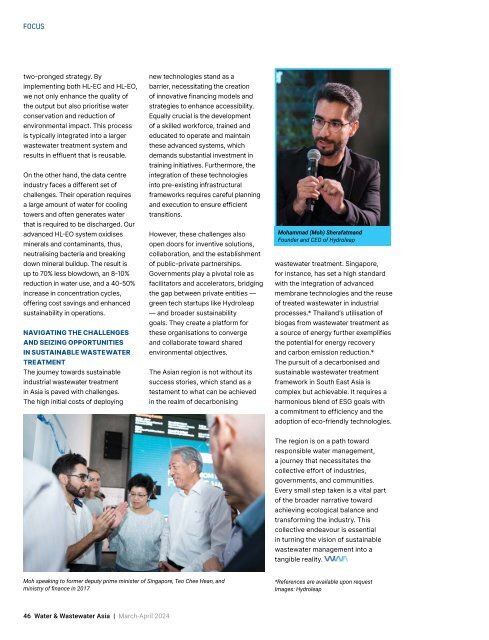Water & Wastewater Asia March/April 2024
Water & Wastewater Asia is an expert source of industry information, cementing its position as an indispensable tool for trade professionals in the water and wastewater industry. As the most reliable publication in the region, industry experts turn this premium journal for credible journalism and exclusive insight provided by fellow industry professionals. Water & Wastewater Asia incorporates the official newsletter of the Singapore Water Association (SWA).
Water & Wastewater Asia is an expert source of industry information, cementing its position as an indispensable tool for trade professionals in the water and wastewater industry. As the most reliable publication in the region, industry experts turn this premium journal for credible journalism and exclusive insight provided by fellow industry professionals. Water & Wastewater Asia incorporates the official newsletter of the Singapore Water Association (SWA).
You also want an ePaper? Increase the reach of your titles
YUMPU automatically turns print PDFs into web optimized ePapers that Google loves.
FOCUS<br />
two-pronged strategy. By<br />
implementing both HL-EC and HL-EO,<br />
we not only enhance the quality of<br />
the output but also prioritise water<br />
conservation and reduction of<br />
environmental impact. This process<br />
is typically integrated into a larger<br />
wastewater treatment system and<br />
results in effluent that is reusable.<br />
On the other hand, the data centre<br />
industry faces a different set of<br />
challenges. Their operation requires<br />
a large amount of water for cooling<br />
towers and often generates water<br />
that is required to be discharged. Our<br />
advanced HL-EO system oxidises<br />
minerals and contaminants, thus,<br />
neutralising bacteria and breaking<br />
down mineral buildup. The result is<br />
up to 70% less blowdown, an 8-10%<br />
reduction in water use, and a 40-50%<br />
increase in concentration cycles,<br />
offering cost savings and enhanced<br />
sustainability in operations.<br />
NAVIGATING THE CHALLENGES<br />
AND SEIZING OPPORTUNITIES<br />
IN SUSTAINABLE WASTEWATER<br />
TREATMENT<br />
The journey towards sustainable<br />
industrial wastewater treatment<br />
in <strong>Asia</strong> is paved with challenges.<br />
The high initial costs of deploying<br />
new technologies stand as a<br />
barrier, necessitating the creation<br />
of innovative financing models and<br />
strategies to enhance accessibility.<br />
Equally crucial is the development<br />
of a skilled workforce, trained and<br />
educated to operate and maintain<br />
these advanced systems, which<br />
demands substantial investment in<br />
training initiatives. Furthermore, the<br />
integration of these technologies<br />
into pre-existing infrastructural<br />
frameworks requires careful planning<br />
and execution to ensure efficient<br />
transitions.<br />
However, these challenges also<br />
open doors for inventive solutions,<br />
collaboration, and the establishment<br />
of public-private partnerships.<br />
Governments play a pivotal role as<br />
facilitators and accelerators, bridging<br />
the gap between private entities —<br />
green tech startups like Hydroleap<br />
— and broader sustainability<br />
goals. They create a platform for<br />
these organisations to converge<br />
and collaborate toward shared<br />
environmental objectives.<br />
The <strong>Asia</strong>n region is not without its<br />
success stories, which stand as a<br />
testament to what can be achieved<br />
in the realm of decarbonising<br />
Mohammad (Moh) Sherafatmand<br />
Founder and CEO of Hydroleap<br />
wastewater treatment. Singapore,<br />
for instance, has set a high standard<br />
with the integration of advanced<br />
membrane technologies and the reuse<br />
of treated wastewater in industrial<br />
processes.* Thailand’s utilisation of<br />
biogas from wastewater treatment as<br />
a source of energy further exemplifies<br />
the potential for energy recovery<br />
and carbon emission reduction.*<br />
The pursuit of a decarbonised and<br />
sustainable wastewater treatment<br />
framework in South East <strong>Asia</strong> is<br />
complex but achievable. It requires a<br />
harmonious blend of ESG goals with<br />
a commitment to efficiency and the<br />
adoption of eco-friendly technologies.<br />
The region is on a path toward<br />
responsible water management,<br />
a journey that necessitates the<br />
collective effort of industries,<br />
governments, and communities.<br />
Every small step taken is a vital part<br />
of the broader narrative toward<br />
achieving ecological balance and<br />
transforming the industry. This<br />
collective endeavour is essential<br />
in turning the vision of sustainable<br />
wastewater management into a<br />
tangible reality.<br />
Moh speaking to former deputy prime minister of Singapore, Teo Chee Hean, and<br />
ministry of finance in 2017<br />
*References are available upon request<br />
Images: Hydroleap<br />
46 <strong>Water</strong> & <strong>Wastewater</strong> <strong>Asia</strong> | <strong>March</strong>-<strong>April</strong> <strong>2024</strong>

















